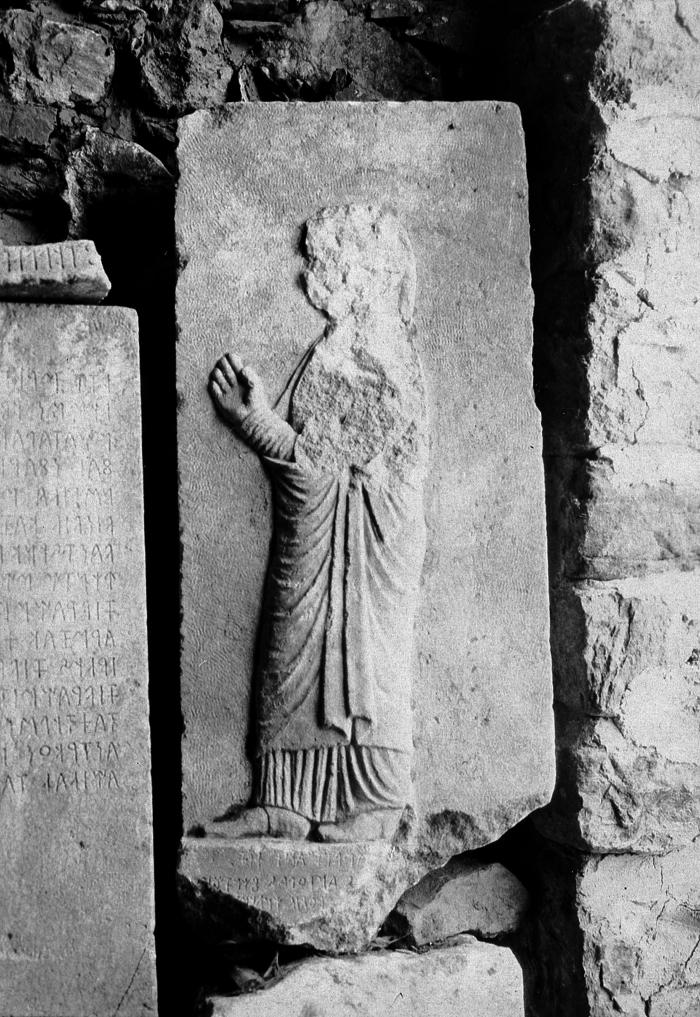-
 Fragment of Pier with Lion’s Head
Fragment of Pier with Lion’s HeadR2 Cat. 222
Sculpture
Marble, Stone
3rd C. AD (Roman)
A lion head is carved on a pillar under a projecting squared capital. The lion has small beady eyes and a simple mane done in parallel locks. A channel runs through his mouth, but because of the pillar behind, this was apparently not originally a fou...
-
 Table Leg, Dionysus Leaning on Pillar
Table Leg, Dionysus Leaning on PillarR2 Cat. 223
Sculpture
Marble, Stone
2nd C. AD (Roman)
Young Dionysus leans on a pillar with l. arm, his hand cupped over the top of the pillar molding. Weight is on his r. leg, the l. one crosses it in front and rests on the ball of the foot. His back is against a second, taller pillar with stepped-out ...
-
 Table Leg, Male Figure Standing against Pillar
Table Leg, Male Figure Standing against PillarR2 Cat. 224
Sculpture
Marble, Stone
2nd C. AD (Roman)
Although the entire head is missing, a strand of hair is preserved on each shoulder. A piece of drapery is wrapped around the left arm at the elbow. The r. hand probably held a staff, since the bottom of some such object is preserved on the base, and...
-
 Table Leg, Male Figure Standing against Pillar
Table Leg, Male Figure Standing against PillarR2 Cat. 225
Sculpture
Marble, Stone
1st half of 3rd C. AD? (Roman)
A nude standing male figure, leaning against a pillar, has a piece of drapery slung across his l. shoulder, around back, and across his r. thigh. Weight is on the l. leg, his r. leg forward. His l. hand clasps the drapery near his chest, the r. hand ...
-
 Socrates Menorah
Socrates MenorahR2 Cat. 226
Sculpture
Marble, Stone
1st half of 4th C. AD? (Roman)
This was originally a seven-branched candlestick with a central vertical stem. Each branch, oval in section, has an incised lozenge pattern (L. 0.05, W. 0.022), carefully but monotonously cut. This pattern is to suggest stylized leaves of rhomboid sh...
-
 Funerary Chest
Funerary ChestR2 Cat. 227
Sculpture
Marble, Stone
1st or 2nd C. AD (Roman)
The chest is profiled at the top and bottom of the wall and stands on four squat legs. The front imitates a wooden chest with metal trimmings. A rectangular lock plate is flanked by two spreading palmettes growing out of an acanthus calyx, all in low...
-
 Chest
ChestR2 Cat. 228
Sculpture
Marble, Stone
Date uncertain (Roman)
A chest of solid stone has at its top a slightly raised platform, in which a round hollow has been cut, and also a channel to the back of the stone. This may have been for the insertion of a statue in the top. The front of the chest has in the center...
-
 Small Head of a Woman?
Small Head of a Woman?R2 Cat. 229
Sculpture
Serpentine, Stone
5th or 4th Millennium BC (Neolithic)
The head is broken from a figurine; enough of the neck remains to show that the head was turned to the proper r. and upward. There is a triangular crease in the center of the forehead. The eyes are asymmetrical, the r. one oval, the I. longer and sli...
-
 Frieze with Grazing Deer
Frieze with Grazing DeerR2 Cat. 230
Sculpture
Marble, Stone
600-550 BC (Lydian)
The square joints at the sides are preserved. The flat moulding is similar to but thinner than that above the relief on Cat. 231 (Fig. 401). In Cat. 230, it runs horizontally below the frieze as a ground line. The relief shows a row of three grazing ...
-
 Frieze of Horsemen
Frieze of HorsemenR2 Cat. 231
Sculpture
Marble, Stone
550-450 BC (Late Lydian (Persian))
The joint on the r. is square, that on the I. is beveled, with a plain vertical band in front indicating the end of the relief. There are two flat moldings along the top and bottom; the space above, below, and between is recessed; and the relief is i...
-
Relief with Head of Bearded Man
R2 Cat. 232
Sculpture
Marble, Stone
500-480 BC (Late Lydian (Persian))
The relief, which is probably from a funerary stele, was described by Richter, but renewed examination shows that the face is bearded and the nose big and elongated (cf. the bearded boxer, Richter, Archaic Gravestones, no. 31, fig. 92) The hairdo and...
-
 Stele with Praying Woman
Stele with Praying WomanR2 Cat. 233
Sculpture
Marble, Stone
450-425 BC (Late Lydian (Persian))
Although there is no sign of dowelling on top, the stele probably had a covering element, possibly a palmette. A female figure facing to I. is placed freely and somewhat asymmetrically on a claw-chiseled background. The sides of the stele are also cl...